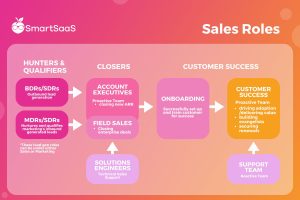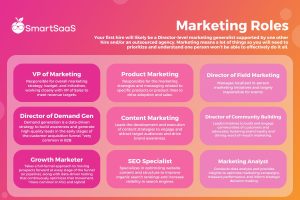Understanding the Structure of an Effective Sales & Marketing Team

Sales and marketing teams are critical to any growing company; they’re responsible for propelling growth, nurturing customer connections, and influencing the future direction of the organization. In this blog post, we’ll demystify the different roles within a sales and marketing team to ensure you can set your own organization up for success.
Sales Roles: The Frontline of Business Growth

The sales team, often the first point of contact with potential customers, is instrumental in championing the company’s offerings and converting prospects into loyal clients. Their roles are diverse, from lead generation and nurturing to deal closing and customer relationship management.
Each role within the sales team brings a unique set of skills and strategies, contributing significantly to the company’s overall revenue and growth. The key to is success is understanding one person can’t do it all. Successful businesses set their sales team up in a way in which each person has a specific role and focus. Let’s examine these roles in detail.
BDRs/SDRs and MDRs/SDRs – The Hunters and Qualifiers
The beginning of the sales process begins with lead generation – the Business Development Representatives (BDRs), Sales Development Representitives (SDRs) and Market Development Representitives (MDRs). These team members are responsible for acquiring new leads, with BDRs/SDRs focusing on outbound lead generation, like cold emailing and cold calling, and MDRs/SDRs nurturing inbound leads. Their roles are critical in filling the sales pipeline, so that Account Executives and Sales reps can take these leads and sell to them. You don’t want your sellers spending all day looking for leads, so this lead gen team is critical to an efficient sales team.
BDRs, SDRs and MDRs can either fall under marketing or sales. More recently, most organizations are putting these roles under marketing given that marketing’s main KPI is pipeline generation.
Account Executives and Field Sales – The Closers
Account Executives (AEs) focus on converting prospects into customers, guiding them through the sales motion. AEs might be doing some of their own prospecting, but they are primarily responsible for taking qualified leads, moving them through the pipeline, overcoming objections, meeting with the buying committee and negotiating until the deal is closed.
Field Sales representatives are the responsibile for going after named accounts. These are usually substantial, enterprise-level deals, that are difficult to close.
Solution Engineers
In some cases, for example with very technical products, it makes sense to also have Solution Engineers supporting sales. Once an Account Executive gets interest, the next call may be more technical (e.g. discussing integration, privacy and security). Solution Engineers join sales calls to answer technical questions and objections.
Onboarding and Customer Success
Once your sales team closes a customer, you may have an onboarding team (or this is handled by your Customer Success team). This team’s goal is to set up and successfully train the customer on the product.
Once onboarded, the customer is then handed over to the Customer Success team. This team is proactive and responsible for driving adoption and delivering value. They’re also responsible for securing renewals, and, depending on your company, may also cross-sell and upsell.
Customer Support is a reactive team in the case of simple questions and problems. They provide a quick and efficient way for customer to have their questions answered.
Marketing Roles: Crafting the Company’s Voice and Vision

The marketing team, a creative and strategic powerhouse, is responsible for building pipeline and developing the company’s branding, messaging, and market positioning. Their roles range from strategic planning and execution to content creation and community engagement.
Marketing priorities will vary depending on if you’re a product-led or sales-led company. Depending on where your company falls, this will impact how you structure your team and who you hire first.
The Director-level Marketing Generalist
The first hire on a marketing team is often a director-level generalist, a versatile hire overseeing various marketing domains depending on your business and their strengths. This role is crucial in shaping the initial marketing strategy, tailored to the company’s unique dynamics and objectives. They’re often supported by one other hire and an outsourced agency until it’s time to build a team.
The VP of Marketing
The VP of Marketing is responsible the overall marketing strategy and budget. This role is instrumental in steering marketing campaigns and assessing their impact. This person works closely with VP of Sales to meet revenue targets.
Director of Demand Gen
Demand generation is a data-driven strategy to build awareness and generate high-quality leads in the early stages of the customer acquisition funnel. This is a very common role in B2B companies with a sales-led strategy.
Growth Marketer
This role is responsible for taking a full-funnel approach to moving prospects forward at every stage of the funnel, along with data-driven testing that continuously optimizes that movement. This is a more common role in companies with product-led growth strategies.
Product Marketing and Field Marketing Directors
Product Marketing and Field Marketing Directors are the specialized tacticians in the team. The former focuses on marketing specific products or lines, driving sales and adoption, while the latter manages localized, in-person marketing initiatives, including event management. Field Marketers are common in industries that are very local or in-person focused.
Content Marketing
Leads the development and execution of content strategies to engage and attract target audiences and drive brand awareness. They also develop content like case studies and ROI calculators to help nurture deals through the pipeline.
SEO Specialist
This role specializes in optimizing website content and structure to improve organic search rankings and increase visibility in search engines. This is often outsourced to an agency in the early days of a marketing team.
Marketing Analyst
Marketing Analysts conduct data analysis and provides insights to optimize marketing campaigns, measure performance, and inform strategic decision-making.
To Wrap Up
Ultimately, the composition of a sales and marketing team comes down to your own business and what strategies make the most sense for your product and market. Understanding each role is crucial for building a team that is resilient, responsive, and efficient.






test comment1